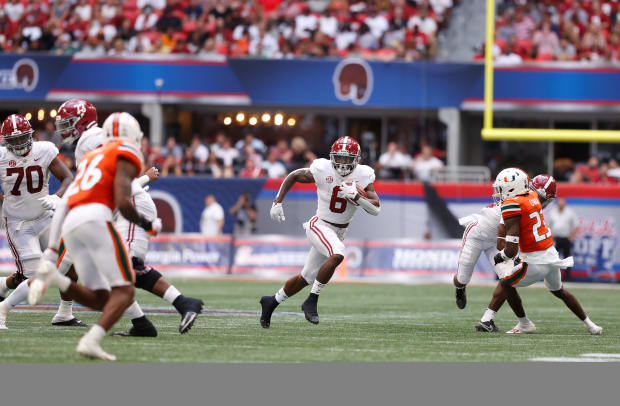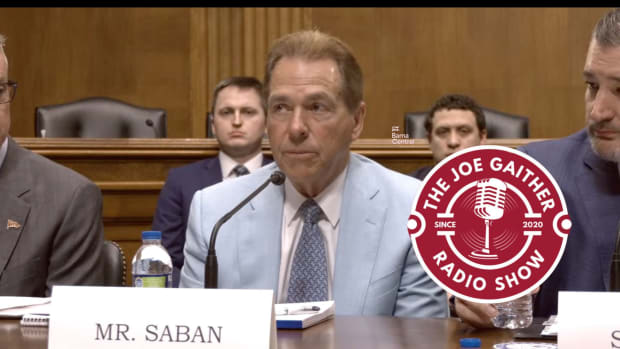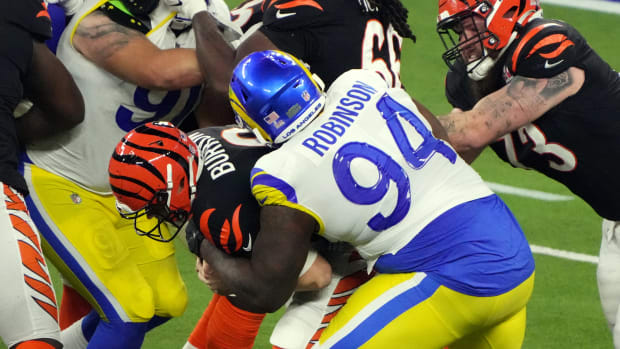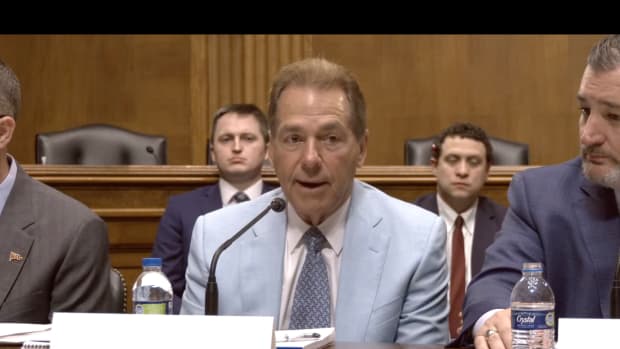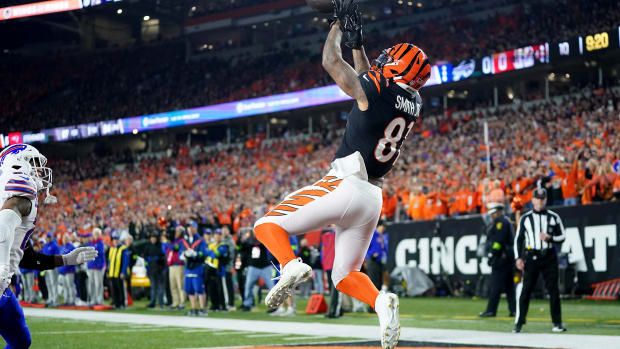To Alabama RB Trey Sanders, a Picture is Worth 1,000 Words
Before we fully dive into today's cover story, I'd like to share a photograph of, in this writer's opinion, the best moment from last Saturday's 44-13 victory for Alabama football over Miami.
No, the photo isn't a highlight from quarterback Bryce Young's stellar debut as the Crimson Tide's signal caller, nor is it a photo of wide receiver Jameson Williams crossing the goal line after his 94-yard touchdown reception — the second longest in school history.
No, the photo is of something far more simple. Yet at the same time, like with every photo, there is a far deeper story behind what the eyes can see at first glance.
Here, take a look:
Midway through the third quarter against the Hurricanes inside Mercedes-Benz Stadium, Alabama redshirt-sophomore running back Trey Sanders rushed for his first career touchdown. After two years of injuries that caused much adversity, Sanders rushed for 41 yards on eight carries.
After his lone rushing touchdown, Sanders quickly returned to the sidelines to celebrate. However, his teammates weren't the first people to greet him. Jogging over to the hashmarks at midfield, Sanders found Jeremy Gsell, the director of football rehabilitation at UA. There, the two shared a moment. Not simply a moment of celebration for the six points Sanders had added to the scoreboard, but the overcoming of so much adversity that the young running back had endured and outlasted.
"Man, I think that was one of the moments in the game that was really special for everybody," wide receiver John Metchie III said. "I think just all of us kind of knowing what he’s been through and all the work that he’s put in and just being able to see that moment, it was just special for everybody."
The top-ranked running back recruit of the 2019 class, Trey Sanders has had a rough go of it. After arriving with much hype surrounding his vast potential with the Crimson Tide, Sanders settled into his role quickly in fall camp. However, his first bout with adversity soon followed. During fall camp, Sanders suffered a Lisfranc injury in his foot that forced him to remain sidelined for his entire freshman campaign.
After all of the excitement heading into his freshman year, it was over before it even began.
During the bye week of his redshirt-freshman season in 2020, Sanders once again was faced with injuries. This time, though, it was more serious. In four games, Sanders had rushed 134 yards on 30 carries but hadn't been able to cross the goal line. However, he had at least been able to play — something that he hadn't been able to do his freshman season.
While at home for just a few days to rest and recuperate in his home town of Port Saint Joe, Florida, Sanders was involved in an automobile accident that resulted in him being air-lifted to a nearby hospital. While he wasn't at the wheel at the time of the accident, he sustained serious injuries that resulted in him needing to use a wheelchair upon his return to Tuscaloosa.
“He got T-boned in his car," Alabama coach Nick Saban said soon after the accident last October. "He wasn’t driving, but they were just pulling out to go across an intersection and he got hit on his side. We’re thankful. He’s got some very serious injuries, but everything has worked out very well. I think he’ll make a full recovery, but this is probably gonna be a several month type thing. He had a hip injury, but not the same kind that Tua [Tagovailoa] had, so there shouldn’t be any question about his recovery.
“We feel very fortunate.”
Once again, Sanders was forced to simply watch as his opportunity to get the ball rolling on his college football career passed him by once again.
Over the next 10 months, Sanders concentrated on nothing other than rehabilitating his injuries. While official details of his injuries were never released to the general public, it was known that he suffered a serious hip injury that could have ended his football-playing career. That being said, Sanders took it in stride.
It was during his rehabilitation that Sanders met with Gsell. Gsell, along with UA director of sports medicine Jeff Allen, quickly began to form a plan to get Sanders back on the field.
Sanders was unable to play when the spring football season started in Tuscaloosa. While he was able to ultimately participate in some drills, his injuries kept him from being able to make contact and forced him to only participate in practices in a limited capacity.
But Sanders kept pressing forward. By the time fall camp rolled around, Sanders was fully back participating in drills. In August, he was able to play in contact drills for the first time since sustaining his injuries.
Last Thursday before Alabama's season opener, Saban revealed that Sanders was the player that he most anticipated seeing in the game during his weekly segment on the Hey Coach! radio program. While it had been assumed that Sanders would see some action in the Crimson Tide's debut game, the official announcement that Sanders was fully back caused excitement to surge once again in the fan base.
With Sanders' touchdown on Saturday, all of the adversity, rehabilitation, mental fortitude and hard work reached its payoff.
Upon further details being revealed, Sanders' injuries were much more serious than even the general public had ever realized. According to Saban, there were moments when both he and his staff — along with Sanders himself — pondered whether returning the football was in the cards for the young rusher.
"There was a point in time where I think he questioned — and a lot of us questioned — would he really be able to come back," Saban said. "And because of his perseverance and his resilience to continue to work the way he did is what allowed him to come back.
"When you see a player go through that kind of adversity, it certainly makes them stronger as a person but you also have a great feeling for seeing them be able to come back and do well in the game — score a touchdown and have some positive plays. Certainly for him, it's got to be a great confidence builder as well."
The photograph of Sanders and Gsell is far more than simply a touchdown celebration. It is so much more than a warm embrace shared between a player and team personnel. No, the photo depicts even more than that. To Sanders and Gsell, it represents the overcoming of life's biggest trials; the culmination of countless hours of rehabilitation, many sleepless nights of never-ending questions and the struggles of leaping over challenging hurdles.
Saturday's touchdown might have been the first of Sanders' career, but it certainly won't be his last. Now poised as the No. 2 running back on the team, Alabama fans can look forward to seeing a lot more of Sanders in the near future.
For Saban, seeing Sanders cross the goal line meant more than simply adding another six points to his program's side of the scoreboard.
"There's probably nobody on our team that has had more adversity and more things to overcome," Saban said after Saturday's win over Miami. "So I was as happy as all get out to see him score a touchdown today.
"Most people don't know how hard this guy's worked to try to get back as a football player. So anyway, I was really, really pleased about that."
Gallery: Trey Sanders Returns to Gridiron
Photos courtesy of Alabama Athletics

